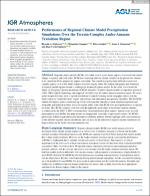Mostrar el registro sencillo del ítem
Performance of Regional Climate Model Precipitation Simulations Over the Terrain-Complex Andes-Amazon Transition Region
| dc.contributor.author | Armijos, Elisaa, | |
| dc.contributor.author | Gutierrez, Ricardo A. | |
| dc.contributor.author | Junquas, Clémentinec | |
| dc.contributor.author | Armijos, Elisaa | |
| dc.contributor.author | Sörensson, Anna A. | |
| dc.contributor.author | Espinoza, Jhan-Carloc | |
| dc.date.accessioned | 2024-03-15T22:16:40Z | |
| dc.date.available | 2024-03-15T22:16:40Z | |
| dc.date.issued | 2024 | |
| dc.identifier.issn | 2169897X | |
| dc.identifier.uri | https://hdl.handle.net/20.500.12542/3168 | |
| dc.description.abstract | Regional climate models (RCMs) are widely used to assess future impacts associated with climate change at regional and local scales. RCMs must represent relevant climate variables in the present-day climate to be considered fit-for-purpose for impact assessment. This condition is particularly difficult to meet over complex regions such as the Andes-Amazon transition region, where the Andean topography and abundance of tropical rainfall regimes remain a challenge for numerical climate models. In this study, we evaluate the ability of 30 regional climate simulations (6 RCMs driven by 10 global climate models) to reproduce historical (1981–2005) rainfall climatology and temporal variability over the Andes-Amazon transition region. We assess spatio-temporal features such as spatial distribution of rainfall, focusing on the orographic effects over the Andes-Amazon “rainfall hotspots” region, and seasonal and interannual precipitation variability. The Eta RCM exhibits the highest spatial correlation (up to 0.6) and accurately reproduces mean annual precipitation and orographic precipitation patterns across the region, while some other RCMs have good performances at specific locations. Most RCMs simulate a wet bias over the highlands, particularly at the eastern Andean summits, as evidenced by the 100%–2,500% overestimations of precipitation in these regions. Annual cycles are well represented by most RCMs, but peak seasons are exaggerated, especially at equatorial locations. No RCM is particularly skillful in reproducing the interannual variability patterns. Results highlight skills and weaknesses of the different regional climate simulations, and can assist in the selection of regional climate simulations for impact studies in the Andes-Amazon transition zone. | es_PE |
| dc.format | application/pdf | es_PE |
| dc.language.iso | spa | es_PE |
| dc.publisher | American Geophysical Union | es_PE |
| dc.relation.uri | 10.1029/2023JD038618 | es_PE |
| dc.rights | info:eu-repo/semantics/openAccess | es_PE |
| dc.source | Repositorio Institucional - SENAMHI | es_PE |
| dc.source | Servicio Nacional de Meteorología e Hidrología del Perú | es_PE |
| dc.subject | Climate Modeling | es_PE |
| dc.subject | Climatology | es_PE |
| dc.subject | Lluvia | es_PE |
| dc.title | Performance of Regional Climate Model Precipitation Simulations Over the Terrain-Complex Andes-Amazon Transition Region | es_PE |
| dc.type | info:eu-repo/semantics/article | es_PE |
| dc.identifier.doi | doi.org/10.1029/2023JD038618 | |
| dc.identifier.journal | Journal of Geophysical Research: Atmospheres | |
| dc.subject.ocde | https://purl.org/pe-repo/ocde/ford#1.05.09 | es_PE |
| dc.publisher.country | PE | es_PE |
| dc.subject.sinia | precipitacion - Aire y Atmósfera | es_PE |
| dc.type.sinia | text/publicacion cientifica | es_PE |
| dc.identifier.url | https://hdl.handle.net/20.500.12542/3168 | |
| dc.identifier.url | https://hdl.handle.net/20.500.12542/3168 |
Ficheros en el ítem
Este ítem aparece en la(s) siguiente(s) colección(es)
-
Artículo científico [166]







